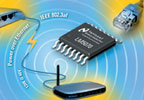

The Internet is becoming as essential and ubiquitous a tool for communication and entertainment as are television and the telephone. An ever-growing variety of powered devices (PDs) such as wireless routers, Web cameras, VoIP phones, and others are finding more and more applications in facilitating and extending the usefulness of the Internet.
All of these devices require a power source to run them and, although the obvious source of this power is the mains, this choice is unattractive because of the additional cables that need to be introduced. A far better solution is to use the Ethernet cable that transfers data to also carry power from the Ethernet hub to the PD, thus eliminating extra cables.
However, there are limits to the power that the Ethernet hub can provide and to the current that the Ethernet cables can handle. To ensure that neither is overloaded and to standardise and streamline the interfacing of PDs to the Ethernet power sourcing equipment (PSE), the IEEE has written the 802.3af Power-over-Ethernet specification to govern the electrical behaviour of Ethernet power loads.
IEEE 802.3af specification
The 802.3af specification allows for power at 44 V to 57 V at the PSE to be delivered to the PD over a CAT-5 or CAT-6 cable by using either spare conductors in the cable or by sharing the data conductors. In the latter case, transformers can be used on both ends of the Ethernet cable to combine and separate the power and data signals.
Design considerations for PoE supplies
Clearly, every PoE power supply must have an 802.3af-compliant powered device interface (PDI) or front end. In the earliest days of PoE power supplies, their compliance to the specification was affected by discrete circuitry added at the front end. The obvious shortcoming of this approach is that of complexity and component count coupled with greater demands on the design skills of the power supply designer.
A refinement of this approach which some IC vendors have followed, is to build just the PDI to ensure compliance with the specification and follow this with a power supply designed around a separate PWM controller. This is an improvement to the previous approach, but still requires the use of two complex ICs for a complete solution.
The PoE PD interface single-chip solution, LM5070
* Combines a fully compliant IEEE 802.3af PD interface with a high-performance current-mode controller.
* Integrates all PD system management including power up/down sequencing and fault protection.
* Provides user programmability of signature impedance, UVLO thresholds, in-rush current, classification current, and DC-DC converter operating parameters.
* Protection for in-rush/fault current limiting, cycle-by-cycle limiting with auto retry, and thermal shutdown.
* Voltage reference and error amplifier for non-isolated applications.
* Available in TSSOP-16 and tiny (5 x 5 mm), thermally-enhanced LLP-16 packages.
For more information, contact Simon Churches, Arrow Altech Distribution, +27 (0)11 923 9600, [email protected]
| Tel: | +27 11 923 9600 |
| Email: | [email protected] |
| www: | www.altronarrow.com |
| Articles: | More information and articles about Altron Arrow |

© Technews Publishing (Pty) Ltd | All Rights Reserved